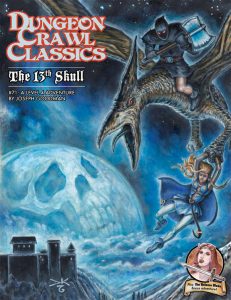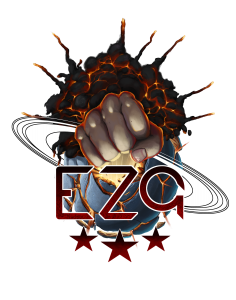The 13th Skull (DCC)

These modules clock in at a total of 24 pages, 1 page front cover, 1 page editorial, 1 page advertisement, 1 page back cover, leaving us with 20 pages of content, so let’s take a look!
This review was requested by a patreon, to be undertaken at my convenience.
Why plural? Well, this one contains two adventures: The eponymous “The 13th Skull”, intended for 6 level 4 characters, and the second one, “The Balance Blade” is intended for 2nd level PCs. Both are written by none other than Joseph Goodman. Beyond these two modules, the pdf offers a supplemental article penned by Daniel J. Bishop – it covers 3 pages and depicts seven magical skulls. The first of these is massive and basically a terrain feature that adds some risk, but also boons to PCs – a major feature you can add to a dungeon. Grandmother’s Skull is interesting, in that it represents a means to converse with a maternal ancestor’s spirit and draw power from it; this is done via a spell check, though spellburn is not per se possible to modify the result; the benefits can be rather potent, but are countermanded by the nature of the ancestor – they have agendas, you know, and 7 sample true natures may be revealed if you really botch the check.
The Lead Skull of the Lost allows PCs to bring fallen comrades back to life, but there is a d30-table of complications that range from beneficial to, well, not, and returning with a magical skull instead of your own? (The item knits flesh over it…) It does change you, you know… The Living Skull of the Emerald Enchanter comes with full stats and makes for a nice addition to the modules featuring that villain. Also fully statted: The Iron Stag, a stag’s skull that allows you assume stag-form. Finally, there is a frontal bone that may be used to scry, provided you accept the spellburn required, and there’s a monkey’s skull atop a staff that is really loud – but which, once in a while, does provide genuinely useful intel…only the players can determine whether that one is worth the risk of using it…
As for the modules themselves: “The 13th Skull” can be undertaken by your average, well-rounded group without much hassle; “The Balance Blade”…well, we’ll get to that later. Both modules have in common that they sport the read-aloud text you’d expect. The former does offer a couple of local legends that are important to contextualize the proceedings in the module.
And this is as far as I can go without diving into SPOILERS. Potential players should jump ahead to the conclusion.
…
..
.
All right, only judges around? Great! The module begins when the PCs watch an execution – but then, things turn weird: The decapitated head of the culprit turns on the very face of the duke, and the executioner unveils a silver skull, gleaming in the hot sun! The executioner grabs the Duke’s daughter with the help of a pterodactyl, and makes off with her! The duke offers a sizeable reward – so yeah, it’ll be up to the PCs to explore the ducal tombs and hopefully save the maiden fair. If they are smart, they’ll ask around first – for it is said that the duke’s family only received their status and wealth courtesy to a horrible pact with the Silver Skull.
Thus, the PCs enter the ducal mausoleum, and the PCs will soon be accosted by tomb shadows, and the skeletons of the ancestors? Well, guess what, they are missing body parts! Astute PCs will notice that the missing parts would make for a full skeleton – not accounting for the universally absent skulls. Ultimately, the PCs will find a secret part of the complex, hidden in the 13th sarcophagus, leading into a massive cavern, where a subterranean river contains an open gate into the lower planes, a hole in the water; the missing bones have been assembled, and a massive pillar, smack in the middle of the river. Several types of devils and the like will be fought, and there are two tasks here: For one, deal with the silver skull seeking to fulfill the infernal bargain – it makes for a deadly boss that smart players may have an edge. The daughter, though? That’s another thing: The PCs can find the Book of Planes, which allows them to travel some planes (a nice trip to the plane of water, for example) and save the damsel from her infernal captor, a barbed devil. Here’s a big issue: The barbed devil has a huge chance of killing off the duke’s daughter with AoE attacks, and the module implies that quick PCs can save her while she’s bound etc.
The issue? We have no idea regarding the dimensions of the room. How far away from the daughter the PCs manifest, and thus, it’s very much unclear how big the chance to save her should be. The combat is laid out as a tactical encounter in a feature-less plane (that is not featured on the map), but fails to specify the spatial relationship between players, adversary and captive, making the most crucial component of the pdf subject to judge fiat, and not in a good way. This is easily the weakest aspect of this otherwise cool, short module, and the only instance that simply doesn’t seem to be fair.
The second module, “The Balance Blade”, comes with the caveat that it works best as a convention game. I’d add that, imho, it ONLY works as a convention game and doesn’t really have a good reason for working as it does. The module is about claiming a legendary artifact, the Balance Blade, for the wizard’s patron. It also requires all alignments to be there; and some prep-work for index cards and stickers that affect the penultimate encounter. I’ll get to that later. So, the complex has components that require certain alignments to pass, and since a rather deadly and mechanically interesting chaos beast is right there in the beginning, unlucky groups that lose required alignments could be locked out of the module right then and there. This is doubly odd, as the challenge posed by the module doesn’t require the alignment component to make the material work; this is solely an arbitrary choice made for the sake of emphasizing alignments.
Aforementioned index cards btw. influence the shape that PCs see from a succubus, and the module encourages PCs going PvP and acting in-game…which does make sense, but at the same time – why doubt your colleagues in a game, where shapechangers are a staple? To quote the module: “For example, when chaotic creatures attack the spider-demon, neutral characters will see their allies striking a child and should react accordingly!” That may work with strangers at a convention. At a homegame, where everybody knows and trusts each other? Where PCs have played with one another for multiple adventures? Not gonna work. At least, I have no idea how to make that reliably work. After walking through an impressive, vast tomb of the last colossus, the PCs will claim the Balance Blade, only to have the wizard/patron go full-blown evil moustache-twirler and attack the others. The reasoning of the patron makes no sense (why kill the allies of the wizard, who have been so great helping the patron’s pawn?), the wizard can’t be saved (DC 30 Will save to resist the patron), etc. This is just frustrating and sucky in any context that is not a convention game, and it’d seriously infuriate me, regardless of who I’d be playing. Considering this very specific context, the lack of pregens is another downside here. This is easily the worst module I’ve read for DCC so far, and frankly, I wouldn’t judge this as a convention either. There are plenty of better options out there.
Conclusion:
Editing and formatting are very good on a formal level, and good on a rules-language level. Layout adheres to Goodman games’ two-column b/w-standard, and features plenty of nice b/w-artworks. The b/w-cartography, as always, is very good, but lacks both a player-friendly version, and in the first module, a map for the most tactical combat in the whole module, for the one combat where positioning REALLY matters, is genuinely a matter of life and death. The pdf version sports basic bookmarks for chapter-headers.
Okay, weird. Usually, Goodman Games’ DCC-modules tend to have something that draws me in, and while “The 13th Skull” has a great premise, a cool, small complex to explore and some evocative ideas, it does fall short in a very crucial encounter. While the handout of a certain book is nice, I couldn’t help but feel like a proper map would have been better there. “The Balance Blade”, to me, is an abject failure that railroads the PCs and their agenda in some seriously sucky ways, that is needlessly meta in its mechanics, and that, ultimately, represents my least favorite DCC-module, regardless of publisher, to date. I seriously HATE it. I don’t just dislike it, I actually HATE it. It represents so many contrivances and things that I loathe in fantasy books, and that never worked well in commercial modules. I can see it work for very specific groups, but I can’t ever see it reward you properly for the amount of prep-work it requires. Daniel J. Bishop’s skulls, finally, and thankfully, I might add, manage to end this one on a higher note.
How to rate this? Well, this is one of the few DCC-modules where I’d advise in favor of skipping it. “The 13th Skull” isn’t bad, but neither is it brilliant; it’s a solid offering for completionists, but you’re better off with pretty much almost every one of the other DCC-modules Goodman Games released. Compared to e.g. the fantastic “People of the Pit”, this falls short in a ton of ways, with “The Balance Blade” being imho wasted wordcount that “the 13th Skull” could have used to further develop its cool planar angle. All in all, my final verdict can’t exceed 3 stars.
You can get this adventure here on OBS!

Endzeitgeist out.
